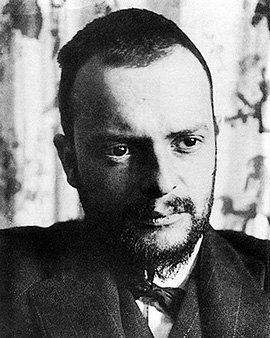Als zweites Kind des Musiklehrers Hans Wilhelm Klee und der Sängerin Ida Klee wuchs Paul Klee praktisch mit Musik auf. Er spielte schon als Kind Geige und trat schon als Elfjähriger öffentlich auf. Noch mehr als die Musik begeisterte den jungen Paul Klee aber die Schriftstellerei und vor allem das Zeichnen. Er kritzelte Karrikaturen in seine Schulhefte und zeichnete viele Motive seiner Heimat. Obwohl seine Eltern ihn unbedingt als Musiker ausgebildet sehen wollten, sperrte sich Klee gegen diesen Wunsch und setzte es schließlich durch, dass er nach der Matura nach München gehen und dort Kunst studieren durfte. Er wurde von dem bekannten Maler und Grafiker Walter Ziegler in der Kunst des Radierens und Ätzens unterrichtet und von Franz von Stuck in der Malkunst. Sein Studium interessierte ihn aber eher am Rande, er genoss in vollen Zügen das freie Studentenleben mit all seinen Verlockungen. Bei einer sechsmonatigen Studienreise durch Italien verliebte sich Klee in die italienische Kunst, ihre Leichtigkeit und Farbenpracht, die gefälligen Proportionen und die kunstvolle Konstruktion. Von der Reise zurückgekehrt, setzte er seine Studien fort, besuchte Anatomiekurse und lernte das Kupferstechen. In dieser Zeit entstanden zehn Radierungen die den Zyklus "Inventionen" bildeten. Nebenbei arbeitete Paul Klee noch als Musiker.
Im Alter von 27 Jahren heiratete der Künstler die Pianistin Lilly Stumpf und zog nach München, wo ein Jahr später sein einziger Sohn Felix geboren wurde. Die Münchner Jahre waren prägend für seine weitere Entwicklung. Er lernte den österreichischen Graphiker und Buchillustrator Alfed Kubin kennen, sowie die Maler August Macke und Wassily Kandinsky. Mit letzterem verband ihn eine enge Freundschaft. Außerdem wurde er Gründungsmitglied und Geschäftsführer der Münchner Künstlervereinigung Sema und Mitglied der Künstlergemeinschaft "Der blaue Reiter".
Die zweite Schaffensperiode von Paul Klee als Maler begann erst 1914. Vorher war er vor allem als Grafiker bekannt. Auf einer Tunesien-Rundreise, die er zusammen mit August Macke und Louis Moillet machte, schrieb er in sein Tagebuch: "Die Farbe hat mich. Ich brauche nicht nach ihr zu haschen. Sie hat mich für immer, ich weiß das. Das ist der glücklichen Stunde Sinn: ich und die Farbe sind eins. Ich bin Maler." Auf der Reise entstanden die bekannten Aquarelle "Ansicht von Kairuan" und "Vue de Saint German". Auch als Soldat im 1. Weltkrieg, wo Klee als Schreiber vom Fronteinsatz verschont blieb, malte er weiter. Nach dem Krieg eröffnete 1920 die erste Kunstausstellung mit 371 Werken des Künstlers in München. Ihr folgten viele weitere, darunter auch internationale in Paris und New York. Paul Klee wurde einer der größten deutschen Maler und Grafiker des Expressionismus, Konstruktivismus und Surrealismus. Außerdem war er auch in der Lehre tätig. Er unterrichtete am Bauhaus in Weimar und Dessau und war Professor an der Kunstakademie Düsseldorf.
×





.jpg)
.jpg)
.jpg)
.jpg)
.jpg)
.jpg)
_-_(MeisterDrucke-696064).jpg)
_-_(MeisterDrucke-696064).jpg)
.jpg)
.jpg)
.jpg)
.jpg)
.jpg)
.jpg)
.jpg)
.jpg)
.jpg)
.jpg)
.jpg)
.jpg)
 - (MeisterDrucke-24669).jpg)
 - (MeisterDrucke-24669).jpg)
.jpg)
.jpg)
.jpg)
.jpg)
.jpg)
.jpg)
.jpg)
.jpg)
.jpg)
.jpg)
.jpg)
.jpg)
.jpg)
.jpg)
.jpg)
.jpg)
.jpg)
.jpg)
.jpg)
.jpg)
.jpg)
.jpg)
.jpg)
.jpg)
.jpg)
.jpg)
.jpg)
.jpg)
.jpg)
.jpg)
.jpg)
.jpg)
_1922_-_(MeisterDrucke-804555).jpg)
_1922_-_(MeisterDrucke-804555).jpg)
.jpg)
.jpg)
.jpg)
.jpg)
_1915242_-_(MeisterDrucke-804624).jpg)
_1915242_-_(MeisterDrucke-804624).jpg)
.jpg)
.jpg)
.jpg)
.jpg)
.jpg)
.jpg)
.jpg)
.jpg)
.jpg)
.jpg)
.jpg)
.jpg)
.jpg)
.jpg)
.jpg)
.jpg)
.jpg)
.jpg)
.jpg)
.jpg)
.jpg)
.jpg)
.jpg)
.jpg)
.jpg)
.jpg)
.jpg)
.jpg)
.jpg)
.jpg)
.jpg)
.jpg)
.jpg)
.jpg)
.jpg)
.jpg)
.jpg)
.jpg)
.jpg)
.jpg)
.jpg)
.jpg)
.jpg)
.jpg)
.jpg)
.jpg)
.jpg)
.jpg)
.jpg)
.jpg)
.jpg)
.jpg)
.jpg)
.jpg)
.jpg)
.jpg)
.jpg)
.jpg)
.jpg)
.jpg)
.jpg)
.jpg)
.jpg)
.jpg)
.jpg)
.jpg)
.jpg)
.jpg)
.jpg)
.jpg)
.jpg)
.jpg)
.jpg)
.jpg)
.jpg)
.jpg)
.jpg)
.jpg)
.jpg)
.jpg)
.jpg)
.jpg)
.jpg)
.jpg)
.jpg)
.jpg)
.jpg)
.jpg)
.jpg)
.jpg)
.jpg)
.jpg)
.jpg)
.jpg)
.jpg)
.jpg)
.jpg)
.jpg)
.jpg)
.jpg)
.jpg)
.jpg)
.jpg)
.jpg)
.jpg)
.jpg)
.jpg)
.jpg)
.jpg)
.jpg)
.jpg)
.jpg)
.jpg)
.jpg)
.jpg)
.jpg)
.jpg)
.jpg)
.jpg)
.jpg)
.jpg)
.jpg)
.jpg)
.jpg)
.jpg)
.jpg)
.jpg)
.jpg)
_-_(MeisterDrucke-1453091).jpg)
_-_(MeisterDrucke-1453091).jpg)
.jpg)
.jpg)
.jpg)
.jpg)
.jpg)
.jpg)
.jpg)
.jpg)






